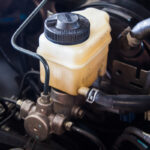
Washing your car is an important step in keeping it looking good and can help extend the life of your vehicle. It’s easy to neglect this chore, but with a few simple tools, you can quickly have it sparkling clean again. Furthermore, washing your own car will save you time and money as opposed to taking it to a professional detailer or waiting in line at the local DIY car wash.
In this blog post, we will provide some basic guidelines for washing a car at home or a service station so that you can keep yours looking great – without breaking the bank!
Table of Contents
Why is Regular Car Washing Necessary?
Regular car washing is necessary for several reasons. Firstly, it helps to remove dirt, grime, and other contaminants that can accumulate on the surface of the car. These contaminants can be harmful to the paint job and can even cause damage to the underlying metal if left unchecked for extended periods.
Secondly, regular car washing helps to maintain the overall appearance of the vehicle. A clean, well-maintained car is more attractive and can even help to maintain its resale value.
Thirdly, regular car washing can help to prevent rust and corrosion from forming on the vehicle’s exterior. Rust and corrosion can be particularly damaging, as they can weaken the metal and even cause structural damage over time.
Finally, regular car washing is important for maintaining good visibility while driving. A dirty windshield or windows can make it difficult to see clearly, which can be dangerous when driving on the road.
Car Wash Tools

- Sponges
- Car wash mitt
First, never wash your car under the sun. Choose a shaded area. Second, it’s crucial to pick equipment that is kind to the paint while still being powerful in eradicating pollution.
As a general rule, plush or deep-napped sponges and mitts perform better than flat-weave towels or dense sponges. When washing, always utilize the sponge’s softer side. Properly rinse new sponges before using them to get rid of any sand or shell fragments.
Pick wash mitts that won’t damage your paint. They shouldn’t scrape or swirl the paint and should be delicate. Wash mitts prevent grit and debris from sticking to your vehicle’s surface by trapping it within the fibers while you wash. To get rid of these impurities, make sure to rinse the mitt frequently.
How to Wash a Car: A Proper Car Washing Guide
The correct order to wash a car

Here are step-by-step instructions for adequately washing an automobile without harming the paint.
1. Clean the tires and wheels first

Simply wash it off when you wash your car if you accidentally splash wheel cleaner or dirt on the car body.
Utilize a cleaner that is safe for wheels. Use a wheel brush to scrub wheels without causing damage. Before moving on to the next one, wash and thoroughly rinse each wheel and tire individually.
Now remove all cleaning supplies, including your sponge and washer bucket, and rinse them.
2. It’s time to wash with a car wash mitt
Let’s begin with clean water, a container that has just been rinsed, and a washing mitt.
Utilizing a lubricant-rich car wash is essential. The goal of a car wash is to get rid of impurities and lubricate them, so they slide off the automobile’s paint without scratching it.
Due to the removal of protective coatings, dish detergents are not recommended.
How can swirl marks be avoided? Use two-bucket method
Use two buckets method: Put clean water in one bucket and soapy water in the other.

Every time you’re prepared to refill your sponge or mitt with soapy water, rinse the grit and contamination off of it by dipping it into the clean water first. After that, wash it once more by dipping it in soapy water.
Always thoroughly rinse your car before washing it to get rid of any loose dirt.
Then start cleaning the vehicle’s top front, then move to the back.

Always keep in mind that the lower panels are the dirtiest. Therefore, to avoid spreading grit to the vehicle’s top half, you should clean the windows and upper panels before cleaning the lower half.
In order to avoid cross-contamination, frequently rinse and reload your sponge.
As you work, rinse your car periodically, especially if it’s hot outside.
To lubricate the sponge, always use soapy water.
If you decide to use a spot cleaning, spray it on before washing the car and then reapply wax to the treated area once the car has dried.
Note: You don’t have to use the water hose to completely rinse your automobile. Your car will rinse more thoroughly if the water flows freely (without a nozzle).
3. Drying the vehicle
Do not omit to dry the car! Never let a car air dry!
To avoid water spots, you must dry your car after washing.
Mineral buildups that carve the outer edge of a water drop into your car’s paint produce water spots.
All water contains minerals, whether from the hose or the sky. The minerals stay on the surface when the water evaporates, and they will unavoidably result in water spots.
While you gather your drying equipment, let the car drip dry for a moment. For your reference, consider the following methods:
Use drying towels and a squeegee

Use a paint-safe squeegee on the windows first if you have one. A synthetic chamois or a microfiber drying towel should be used after the squeegee.
To finish drying the automobile:
- Use a fresh drying towel.
- Work from the top down. If you’re using a large drying towel, spread it out over the flat sections of the car’s surface and slowly bring the cloth toward you.
- Frequently shake and rotate your drying towel.
- Fold your towel into a square before wiping to avoid staining.
- Open the doors when the exterior has largely dried, and clean the jambs, sills, and seal areas.
- Dry the area under the doors before closing them to prevent wet sills.
Use a car dryer
A car dryer can swiftly dry the paint, glass, and wheels of your automobile, as well as the areas under and around the emblems, in the grille, and between the doors.
Steps on How to Wash a Car with A Pressure Washer
A pressure washers can be used to clean your car, but they might not be as effective as professional equipment.
1. Rinse the vehicle
Before using a pressure washer, start by rinsing off the built-up dirt and debris from your car with a garden hose or bucket of water. This will help prevent scratching the paint when pressure washer settings
Most pressure washers come with several settings to adjust the pressure for different jobs. Before starting, make sure you select a setting that’s appropriate for your car.
For light cleaning, use a lower setting of 1,000 PSI or less. Higher pressure levels can cause damage to the vehicle’s clear coat and areas to clean include:
• Wheels and tires
• Door jams and windows
• Engine bay
• Undercarriage
2. Apply soap or detergent
For the most effective cleaning, add a car-specific soap or detergent to the pressure washer’s reservoir tank. This will provide additional lubrication for dirt soaps and detergents include:
• Automobile soap
• Car shampoo
• All-purpose cleaner
• Engine degreaser
3. Begin cleaning the vehicle
Be sure to start at the top of the car, working your way down to prevent streaks from forming. Move the pressure washer nozzle in a areas to focus on are:
• Wheels
• Doors and windows
• Mirrors
• Body panels
4. Rinse the vehicle thoroughly
Rinse off all soap or detergent residue before drying your car with a towel. Always keep the nozzle moving while rinsing to avoid damaging the paint. Also, use a lower pressure setting when working around delicate parts of the car such as door handles, emblems, and trim pieces.
5. Dry the vehicle
Be sure to dry your car after cleaning it with a pressure washer. Use a clean microfiber cloth and work from top to bottom in sections, continually folding and refolding the cloth as it becomes saturated with water. You can also use drying tools include:
• Microfiber cloth
• Squeegee or blade
• Automotive drying towel
• Car dryer
By following these steps, you can easily and effectively wash your car with a pressure washer.
Steps on How to Wash a Car with Foam Canon or Snow Foam
Foam cannons are a great way to wash your car. This method is less labor intensive than traditional hand washing and uses less water for a more eco-friendly experience.
1. Connect the hose and foam canon
Before starting, make sure all connections are secure and tight between the hose and foam canon. This will ensure proper water pressure and cleaning performance.
2. Dilute the shampoo solution
Your foam cannon should come with specific instructions on how to mix the shampoo solution correctly in order to achieve optimal results. Make sure you follow these instructions closely when diluting your soap or detergent! A good rule of thumb is usually one part soap to four parts water for most solutions.
3. Fill up the Foam Cannon reservoir solutions used in foam cannons include:
• Car wash shampoo
• All-purpose cleaner
• Wheel cleaner
• Engine degreaser
Once you have your foam cannon filled with the diluted solution, attach it to the garden hose.
4. Begin cleaning the vehicle
Start at the top of the car and work your way down, spraying sections of the car. Move around any emblems or trim pieces and be sure to keep an even stream of foam without over saturating one area too much. After finishing each section, rinse off all soap or detergent residue with a hose or bucket of water before moving onto the next section.
5. Dry off your vehicle
Be sure to dry off your car using a clean microfiber cloth after washing with a foam canon. Work from top to bottom and continually fold and refold the cloth as it becomes saturated with water. You can also use drying tools such as squeegees or blades for hard-to-reach areas, or an automotive drying towel for large sections of your car.
Steps on How to Wash a Car at Self-service
Washing your car at a self-service car wash can be a convenient and cost-effective way to keep your vehicle looking its best. Here’s a step-by-step guide to help you wash your car at a self-service car wash:
- Check the Equipment: Before starting the wash, check the equipment to make sure everything is in good working order. Check the hoses, nozzles, and brushes for any damage or leaks.
- Choose the Right Setting: Many self-service car washes offer different settings for the water pressure and spray pattern. Choose the setting that’s best for your car, depending on how dirty it is and the type of paint and finish it has.
- Pre-Rinse: Use the high-pressure rinse to pre-rinse your car, starting from the top and working your way down. This will help remove any loose dirt or debris.
- Apply Soap: Apply the soap by using the foam brush or spray nozzle, again starting from the top and working your way down. Be sure to use a soap that is specifically designed for washing cars, as household cleaners or detergents can damage the paint.
- Scrub and Rinse: Use the scrub brush to gently scrub your car, paying extra attention to any areas that are especially dirty. Rinse the soap off using the high-pressure rinse, again starting from the top and working your way down.
- Apply Wax: Many self-service car washes offer an option to apply wax to your car’s exterior. This can help protect the paint and provide a glossy finish.
- Dry Your Car: Use a clean towel or chamois to dry your car, starting from the top and working your way down. Be sure to dry all surfaces thoroughly to prevent water spots.
By following these steps, you can keep your car looking clean and well-maintained without breaking the bank. Just remember to use gentle techniques and products, and always be mindful of the equipment and surroundings to avoid causing any damage.
How to Wash a Car at Automatic Car Wash Station
Washing your car at an automatic car wash station can be a quick and convenient way to keep your vehicle clean. Here’s a step-by-step guide to help you wash your car at an automatic car wash station:
- Choose the Right Car Wash: Automatic car wash stations offer a variety of wash packages, ranging from basic to premium. Choose the package that’s best for your car and your budget.
- Pay for the Wash: Most automatic car wash stations have a pay station where you can select your wash package and pay for the wash. Some may also accept payment through a mobile app.
- Drive into the Wash Bay: Once you’ve paid for the wash, drive your car into the wash bay and stop at the designated spot.
- Follow the Instructions: Automatic car wash stations have clear instructions posted on the walls or on a digital display. Follow the instructions carefully to ensure that your car is washed correctly.
- Stay in Your Car: Most automatic car wash stations are designed for you to stay in your car while it’s being washed. This is for safety reasons and to ensure that the wash is done properly.
- Exit the Wash Bay: After the wash is complete, drive your car out of the wash bay and park in the designated spot for drying.
- Dry Your Car: Use a clean towel or chamois to dry your car, starting from the top and working your way down. Be sure to dry all surfaces thoroughly to prevent water spots.
By following these steps, you can keep your car looking clean and well-maintained with minimal effort. Just remember to choose the right wash package for your car and to follow the instructions carefully to ensure a proper wash.
Common Mistakes People Make when Washing Their Car
Washing a car is a routine task that most drivers perform on a regular basis, but there are several common mistakes that people make when washing their car that can damage the paint or finish. Here are some of the most common mistakes:
- Washing in direct sunlight: Washing a car in direct sunlight can cause water spots and streaks because the water dries too quickly. It’s best to wash your car in a shaded area or during early morning or late evening when the sun is not too strong.
- Using the wrong soap: Using dish soap or other household cleaners can strip the wax and protective coatings from the paint, leaving it vulnerable to damage. It’s important to use a soap specifically designed for cars.
- Using a dirty sponge or cloth: Dirt and debris can accumulate on sponges and cloths, causing them to scratch the paint as you wash the car. It’s important to use clean and soft materials and to rinse them frequently during the washing process.
- Scrubbing too hard: Scrubbing the paint too hard can cause scratches and swirl marks. It’s best to use a gentle touch and let the soap and water do the work.
- Skipping the rinse: Failing to rinse off all the soap can leave a film on the paint that can damage the finish over time. It’s important to rinse thoroughly after washing.
- Using a pressure washer too close to the car: Pressure washers can be too powerful and damage the paint if used too close to the car. It’s best to use a pressure washer from a safe distance or use a garden hose instead.
By avoiding these common mistakes, you can help keep your car looking its best and protect its paint and finish for years to come.
How Much Does It Cost to Wash a Car
The cost of washing a car can vary depending on several factors, including the type of car wash, the location, and the services offered. Here are some general guidelines on the cost of washing a car:
- Self-Service Car Wash: At a self-service car wash, you typically pay for the time you use the equipment. This can range from a few dollars for a quick wash to around $10 for a more thorough cleaning.
- Automatic Car Wash: An automatic car wash usually costs between $5 and $15, depending on the level of service you choose. Basic washes may only include a quick rinse and soap application, while more expensive options may include waxing and detailing.
- Hand Wash: A hand wash from a professional detailing service can range from $20 to $100 or more, depending on the size and type of vehicle and the level of detailing you choose.
- Mobile Car Wash: A mobile car wash service typically charges between $25 and $75, depending on the services offered and the location.
It’s important to note that these prices are general estimates and can vary depending on your location and the specific services offered. Additionally, prices for detailing services such as waxing and polishing can be higher.
Frequent Asked Questions
How often should I wash my car?
It depends on the climate and conditions in which you drive. In general, it is recommended to wash your car every two weeks to once a month. However, if you frequently drive on dirt or gravel roads, or live in an area with lots of snow, salt, or other road debris, you may need to wash your car more often.
What is the best way to wash my car?
The best way to wash your car is to start by rinsing it with a hose or pressure washer to remove any loose dirt and debris. Then, use a high-quality car wash soap and a clean sponge or mitt to wash the car in sections, rinsing each section before moving on to the next. After washing, rinse the car thoroughly and dry it with a microfiber towel or chamois.
What kind of soap should I use to wash my car?
It is best to use a soap specifically designed for washing cars, as regular household detergents can strip the wax and protective coatings from the car’s surface. Look for a pH-balanced soap that is gentle on the paint and will not leave a residue.
What is the best way to dry my car after washing it?
The best way to dry your car after washing it is to use a microfiber towel or chamois. Start by gently patting the car’s surface to remove excess water, then use a back-and-forth motion to dry the car in sections.
What kind of sponge or cloth should I use to wash my car?
It is best to use a clean, soft sponge or microfiber mitt to wash your car. Avoid using rough or abrasive materials, as these can scratch the paint.
How can I avoid scratching my car when washing it?
To avoid scratching your car when washing it, use a high-quality car wash soap and a clean sponge or mitt. Avoid using rough materials or scrubbing too hard, as this can damage the paint. Rinse your sponge or mitt frequently to remove any dirt or debris that may have accumulated.
What are some tips for washing a car in the winter?
When washing a car in the winter, it is important to use warm water and a car wash soap that is formulated for use in cold temperatures. It is also a good idea to wash the car in a sheltered area, such as a garage or carport, to prevent the water from freezing before you can dry the car.
After washing, dry the car thoroughly to prevent water from freezing on the surface. Additionally, avoid using hot water to wash your car in the winter, as this can cause the cold glass to crack.
Can I use Dawn dish soap to wash my car?
While Dawn dish soap can be effective at removing dirt and grime, it is not recommended for washing cars as it can strip away wax and protective coatings from the paint, leaving it vulnerable to damage.
What soap can be used to wash a car?
It is best to use a soap specifically formulated for washing cars. Look for a pH-balanced soap that is gentle on the paint and will not leave a residue.
How can I wash my car without damaging it?
To wash your car without damaging it, use a high-quality car wash soap and a clean sponge or mitt. Avoid using rough materials or scrubbing too hard, as this can damage the paint. Rinse your sponge or mitt frequently to remove any dirt or debris that may have accumulated. Additionally, avoid washing your car in direct sunlight or when the surface is hot, as this can cause water spots and streaks.
What are some tips for washing a car in the summer?
When washing a car in the summer, it is important to work quickly and avoid washing the car in direct sunlight or when the surface is hot. Rinse the car frequently to prevent soap from drying on the surface, and dry the car thoroughly to prevent water spots.
How can I remove bugs or tar from my car’s paint?
To remove bugs or tar from your car’s paint, you can use a specialized bug and tar remover or a mixture of warm water and a gentle soap. Apply the solution to the affected area and let it sit for a few minutes, then gently scrub with a soft sponge or microfiber towel. Rinse the area thoroughly and dry it with a clean towel.
How to wash a car without a hose?
You can wash a car without a hose by using a bucket of water and a sponge or microfiber mitt. Dip the sponge or mitt into the water, wring it out, and use it to wash the car in sections. Rinse the sponge or mitt frequently to remove dirt and debris, and dry the car with a microfiber towel or chamois.
Can I use shampoo to wash my car?
While shampoo may be effective at removing dirt and grime, it is not recommended for washing cars as it can strip away wax and protective coatings from the paint, leaving it vulnerable to damage. It is best to use a soap specifically formulated for washing cars.
—
How to wash a car is simple, but many neglect it. Regular washing is essential for car detailing. Using high-quality tools and cleaning supplies to complete the task properly makes life simpler and reduces scratching.
Washing is merely the first cleaning procedure for a complete detailing task. Washing gets rid of loose dirt, but it won’t get rid of contamination that is bonded. We must do a complete exterior detailing job if we want a deep clean, shining appearance.
Thank you for reading. For more articles, please check out cardetailingart.com!
Further Reading:
- Car Washes: Compliance Resources
- Environmental Rules for Car Washes
- Rules and Regulations: For Car Washing and Polishing
- How to Wash a Car by Hand: DIY Guide for Beginners – wikiHow
- Easy Ways to Go Through a Car Wash – wikiHow
- How to Use a Self-Service Car Wash: Beginner-Friendly Guide







